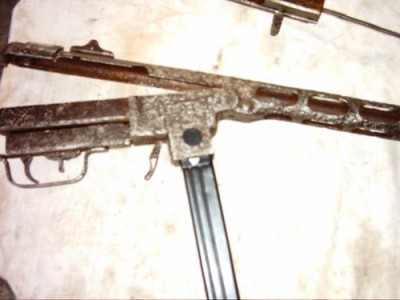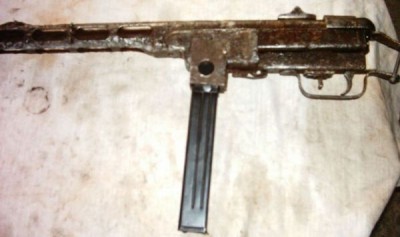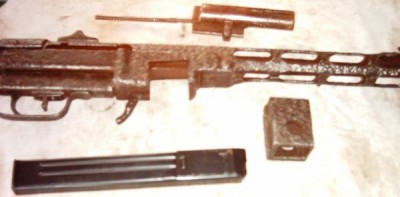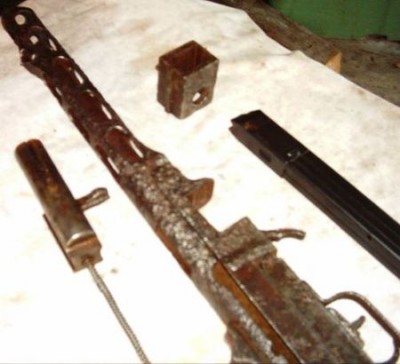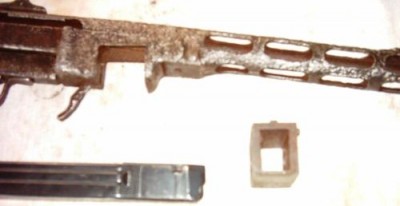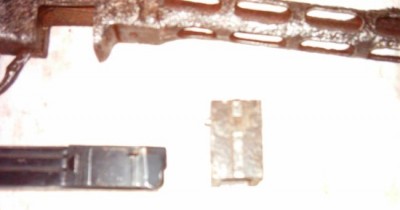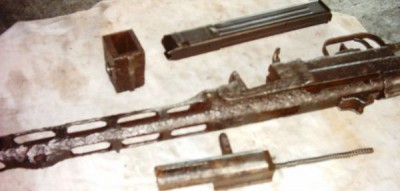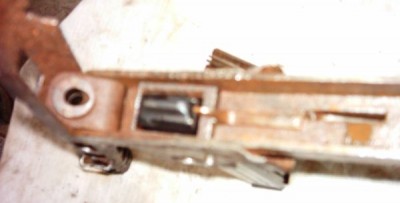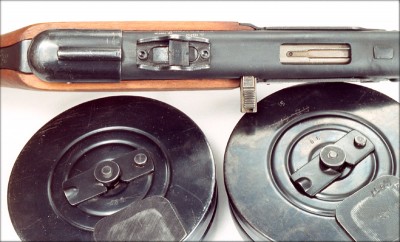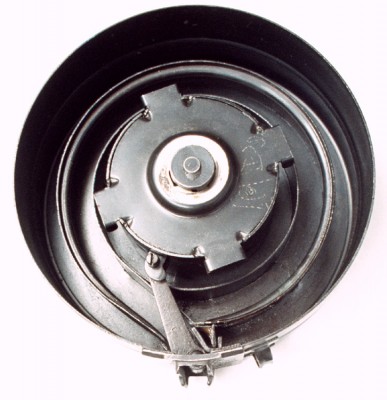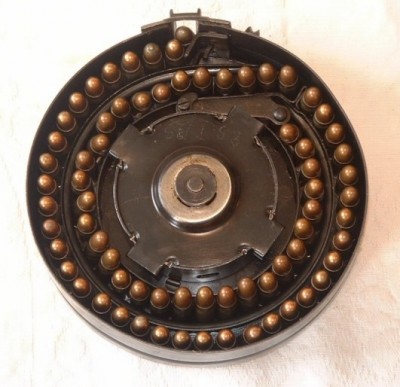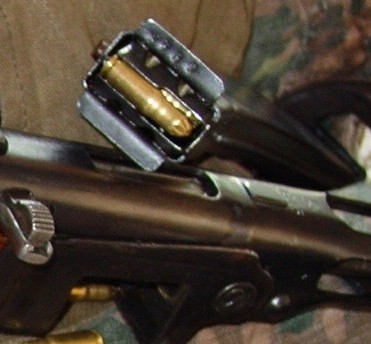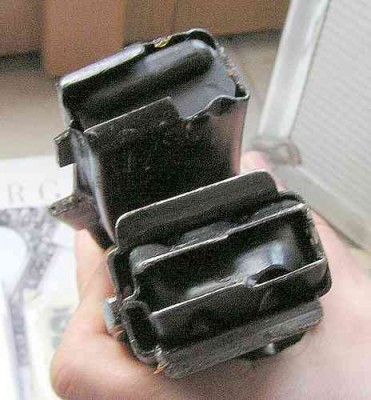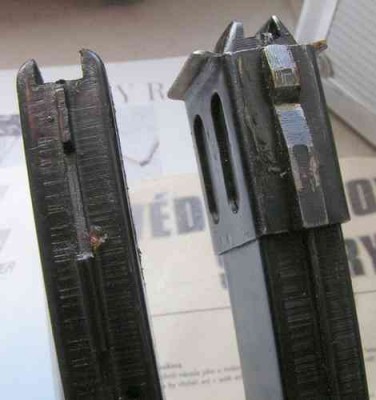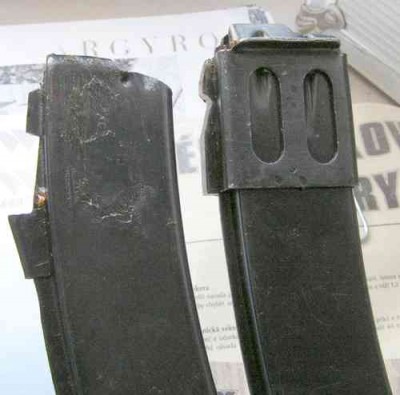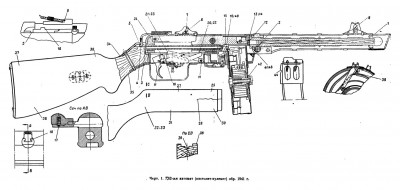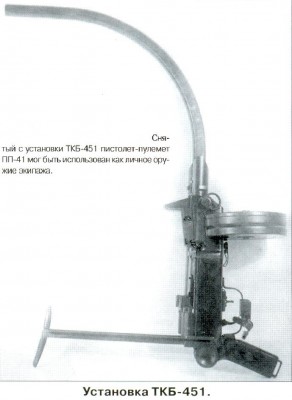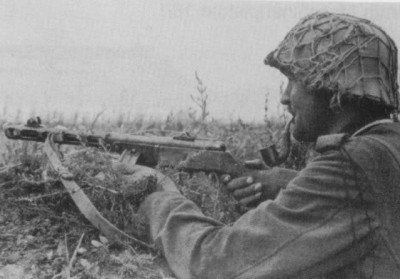| Název: Name: | PPŠ-41 (7,62 mm samopal vzor 1941 systému Špagina) | PPSh-41 (0.3in Submachine-gun model 1941, Shpagin's system) |
| Originální název: Original Name: | ППШ-41 (7,62-мм пистолет-пулемёт образца 1941 года системы Шпагина) | |
| Kategorie: Category: | samopal | sub-machinegun |
| Výrobce: Producer: | DD.MM.RRRR-DD.MM.RRRR Státní zbrojovky, ? | |
| Technické údaje: Technical Data: | ||
| Hmotnost nenabité zbraně: Weight Unloaded: | 4,2 kg | 9.26 lb |
| Ráže: Calibre: | 7,62 mm | |
| Náboj: Cartridge: | 7,62 x 25 Tokarev | |
| Délka: Length: | 842 mm | 2ft 9,14in |
| Délka hlavně: Barrel Length: | 269 mm | 10,59in |
| Kapacita zásobníku: Magazine Capacity: | 35, 71 | |
| Výkony: Performance: | ||
| Rychlost střelby: Rate of Fire: | 900 ran/min | 900 rpm |
| Úsťová rychlost: Muzzle Velocity: | 500 m/s | 1640.4 ft/s |
| Uživatelské státy: User States: | ||
| Poznámka: Note: | Němci ukořistili poměrně mnoho těchto zbraní a pod označením 7,62 mm MP 717(r) je používali. Existuje i německé provedení v ráži 9 mm Luger, k této zbrani se pak dodával adaptér pro použití zásobníků z MP-40. Zajímavostí je plstěný nebo plastový doraz, tlumící závěr při jeho doběhu do zadní polohy v pouzdře závěru. Zajímavostí jsou také odvozené varianty této zbraně- vietnamský samopal K-50M, jugoslávký M49/57 a chorvatské samopaly Jelen a Šokac. V Číně se vyráběl jako Type 50 a v Severní Korei jako Type 49, v Polsku jako wz.41 a v Maďarsku jako Typ 48. | - |
| Zdroje: Sources: | - | |
SOV - PPŠ-41
PPSh-41
ППШ-41
Several photos of the last addition to my collection - devalued PPŠ-41, year of manufacture 1944.
General view from both sides:
[img] https://galerie.valka.cz/data/633/medium/PICT0005~0.JPG[/img ]
[img] https://galerie.valka.cz/data/633/medium/PICT0006~0.JPG[/img ]
View of the breech case. Note the sliding locks on the lock tensioner handle. This lock blocked the lock in its front and rear positions. In both pictures, the fuse is in the "unlocked" position:
[img] https://galerie.valka.cz/data/633/medium/PICT0007~0.JPG[/img ]
[img] https://galerie.valka.cz/data/633/medium/PICT0012.JPG[/img ]
Trigger trigger. Note the serial number on the trigger guard:
[img] https://galerie.valka.cz/data/633/medium/PICT0017.JPG[/img ]
[img] https://galerie.valka.cz/data/633/medium/PICT0016.JPG[/img ]
Ejection window. The embossing of the year of manufacture and the serial number in front of the window is clearly visible:
[img] https://galerie.valka.cz/data/633/medium/PICT0009~0.JPG[/img ]
Detail of the left side of the breech housing with a visible hinge pin. Note the spot welds:
[img] https://galerie.valka.cz/data/633/medium/PICT0021.JPG[/img ]
The lower part of the barrel casing (holes in the barrel are part of the devaluation of the weapon):
[img] https://galerie.valka.cz/data/633/medium/PICT0019.JPG[/img ]
The front part of the casing is mainly with noticeable grinding of welds:
[img] https://galerie.valka.cz/data/633/medium/PICT0011~0.JPG[/img ]
[img] https://galerie.valka.cz/data/633/medium/PICT0030.JPG[/img ]
Rear part of the closure housing with visible serial number (and weld for deterioration):
[img] https://galerie.valka.cz/data/633/medium/PICT0029.JPG[/img ]
[img] https://galerie.valka.cz/data/633/medium/PICT0022.JPG[/img ]
Attaching the drum magazine from the front ...
[img] https://galerie.valka.cz/data/633/medium/PICT0018.JPG[/img ]
... and from behind:
[img] https://galerie.valka.cz/data/633/medium/PICT0020.JPG[/img ]
Drum tray mount on the right. In the first frame, the magazine catch lever is lowered, in the second frame, it is lowered:
[img] https://galerie.valka.cz/data/633/medium/PICT0014.JPG[/img ]
[img] https://galerie.valka.cz/data/633/medium/PICT0015.JPG[/img ]
Sliding visor, tilting to two positions (note the riveted visor base):
[img] https://galerie.valka.cz/data/633/medium/PICT0013.JPG[/img ]
[img] https://galerie.valka.cz/data/633/medium/PICT0008~0.JPG[/img ]
Fly with resistance welded protector:
[img] https://galerie.valka.cz/data/633/medium/PICT0010~0.JPG[/img ]
Front and rear carrier belt bracket:
[img] https://galerie.valka.cz/data/633/medium/PICT0024.JPG[/img ]
[img] https://galerie.valka.cz/data/633/medium/PICT0023.JPG[/img ]
Stock shoe with closed and open cylindrical cavity cover for storage of cleaning:
[img] https://galerie.valka.cz/data/633/medium/PICT0028.JPG[/img ]
[img] https://galerie.valka.cz/data/633/medium/PICT0027.JPG[/img ]
General view from both sides:
[img] https://galerie.valka.cz/data/633/medium/PICT0005~0.JPG[/img ]
[img] https://galerie.valka.cz/data/633/medium/PICT0006~0.JPG[/img ]
View of the breech case. Note the sliding locks on the lock tensioner handle. This lock blocked the lock in its front and rear positions. In both pictures, the fuse is in the "unlocked" position:
[img] https://galerie.valka.cz/data/633/medium/PICT0007~0.JPG[/img ]
[img] https://galerie.valka.cz/data/633/medium/PICT0012.JPG[/img ]
Trigger trigger. Note the serial number on the trigger guard:
[img] https://galerie.valka.cz/data/633/medium/PICT0017.JPG[/img ]
[img] https://galerie.valka.cz/data/633/medium/PICT0016.JPG[/img ]
Ejection window. The embossing of the year of manufacture and the serial number in front of the window is clearly visible:
[img] https://galerie.valka.cz/data/633/medium/PICT0009~0.JPG[/img ]
Detail of the left side of the breech housing with a visible hinge pin. Note the spot welds:
[img] https://galerie.valka.cz/data/633/medium/PICT0021.JPG[/img ]
The lower part of the barrel casing (holes in the barrel are part of the devaluation of the weapon):
[img] https://galerie.valka.cz/data/633/medium/PICT0019.JPG[/img ]
The front part of the casing is mainly with noticeable grinding of welds:
[img] https://galerie.valka.cz/data/633/medium/PICT0011~0.JPG[/img ]
[img] https://galerie.valka.cz/data/633/medium/PICT0030.JPG[/img ]
Rear part of the closure housing with visible serial number (and weld for deterioration):
[img] https://galerie.valka.cz/data/633/medium/PICT0029.JPG[/img ]
[img] https://galerie.valka.cz/data/633/medium/PICT0022.JPG[/img ]
Attaching the drum magazine from the front ...
[img] https://galerie.valka.cz/data/633/medium/PICT0018.JPG[/img ]
... and from behind:
[img] https://galerie.valka.cz/data/633/medium/PICT0020.JPG[/img ]
Drum tray mount on the right. In the first frame, the magazine catch lever is lowered, in the second frame, it is lowered:
[img] https://galerie.valka.cz/data/633/medium/PICT0014.JPG[/img ]
[img] https://galerie.valka.cz/data/633/medium/PICT0015.JPG[/img ]
Sliding visor, tilting to two positions (note the riveted visor base):
[img] https://galerie.valka.cz/data/633/medium/PICT0013.JPG[/img ]
[img] https://galerie.valka.cz/data/633/medium/PICT0008~0.JPG[/img ]
Fly with resistance welded protector:
[img] https://galerie.valka.cz/data/633/medium/PICT0010~0.JPG[/img ]
Front and rear carrier belt bracket:
[img] https://galerie.valka.cz/data/633/medium/PICT0024.JPG[/img ]
[img] https://galerie.valka.cz/data/633/medium/PICT0023.JPG[/img ]
Stock shoe with closed and open cylindrical cavity cover for storage of cleaning:
[img] https://galerie.valka.cz/data/633/medium/PICT0028.JPG[/img ]
[img] https://galerie.valka.cz/data/633/medium/PICT0027.JPG[/img ]
Reklama
: roll:
So I took a picture of the 9mm Para Spaghetti looking after 60 years in the country.
I dug it around Hrabyně in the Ostrava region in a ditch about 75 cm deep. The site was littered with trenches and craters after artillery fire. There were a lot of fired cartridges and ammunition both 9mm and 8x57JS and 7.62x25 and 7.62x54. I was glad that I found at least PPŠ-41, the wood fell apart after being pulled out of the ground, the lower part, but rather half of the tank also fell apart. When I roughly cleaned it of dirt and a little steel brush, I was surprised that the hopper was straight and not curved. I soaked it in diesel and pulled it out after a week. After a more thorough cleaning, I was fascinated by the reduction on the magazine, there were still 3 rounds in it, one of them in the chamber. To my great surprise, not 7.62x25 but 9mm Para. The overall condition is nice to the fact that lying 60 years in the country went quite effortlessly disassemble. The barrel is interesting in that it is about 35 mm shorter than the original, so it is missing about 15 mm into the hole in the front (you can see it in one photo) and has 4 guide grooves. It is on average wider than 7.62 but there are no visible marks or markings on it. The most interesting is the reduction, it can be pulled out and the MP-40 magazine can be inserted into it (it is new in the photos), it has a label on the side. Even on the reduction to the hopper, there are no visible marks or markings. I broke the trigger mechanism. The conclusion is idetic with 7.62 without any modifications it is not possible to read the number. There are no visible numbers or beginnings on the body of the weapon or on the bow. (Photos are as I managed)
So I took a picture of the 9mm Para Spaghetti looking after 60 years in the country.
I dug it around Hrabyně in the Ostrava region in a ditch about 75 cm deep. The site was littered with trenches and craters after artillery fire. There were a lot of fired cartridges and ammunition both 9mm and 8x57JS and 7.62x25 and 7.62x54. I was glad that I found at least PPŠ-41, the wood fell apart after being pulled out of the ground, the lower part, but rather half of the tank also fell apart. When I roughly cleaned it of dirt and a little steel brush, I was surprised that the hopper was straight and not curved. I soaked it in diesel and pulled it out after a week. After a more thorough cleaning, I was fascinated by the reduction on the magazine, there were still 3 rounds in it, one of them in the chamber. To my great surprise, not 7.62x25 but 9mm Para. The overall condition is nice to the fact that lying 60 years in the country went quite effortlessly disassemble. The barrel is interesting in that it is about 35 mm shorter than the original, so it is missing about 15 mm into the hole in the front (you can see it in one photo) and has 4 guide grooves. It is on average wider than 7.62 but there are no visible marks or markings on it. The most interesting is the reduction, it can be pulled out and the MP-40 magazine can be inserted into it (it is new in the photos), it has a label on the side. Even on the reduction to the hopper, there are no visible marks or markings. I broke the trigger mechanism. The conclusion is idetic with 7.62 without any modifications it is not possible to read the number. There are no visible numbers or beginnings on the body of the weapon or on the bow. (Photos are as I managed)
The PPŠ submachine gun (Pistole-pulemjot Špagina) designed Georgij Semjonovič Špagin and was introduced into the armament of the Red Army on 21.12.1940. It was primarily designed for the use of a drum magazine with a capacity of 71 rounds, but due to problems with its reliable function, a segmented magazine for 35 rounds was introduced in February 1942. Thus, the submachine gun could (similarly to Suomi) use two types of magazines. In terms of production technology, it was a simpler weapon than the PPD vz. 40.
Source: Shooting Magazine
Source: Shooting Magazine
Reklama
Elsewhere in the forum, we got into a debate about whether the magazine for PPS 43 is interchangeable with the segment magazine for PPŠ 41, I didn't like it and I started looking for it and I checked the weapons in the museum (unfortunately it was impossible to take pictures there). in some publications this was not possible. the magazine for PPŠ 41 has a kind of sleeve made around its upper part which passes into the "wings" widened to the side, ensuring that the narrow segmental magazine in the shaft which does not have sides does not turn to the sides. It cannot therefore be inserted into the PPS 43 shaft (it is closed at the sides). On the net I also found a photo of the mouth of the magazine (it is filled with blanks) where it is easy to see. The segment tanks were originally made of 0.5 mm thick sheet metal, but these proved to be insufficiently strong, so they switched to production from 1 mm thick sheet metal. Segment magazines were introduced because charging the drum magazine was laborious and was quite problematic, usually a soldier carried one drum magazine in a catfish belt and another two to three segment in uniform pockets.
I will also add a photo of a filled drum magazine where, compared to the previous one, it is easy to see how the charges are actually conducted.
I will also add a photo of a filled drum magazine where, compared to the previous one, it is easy to see how the charges are actually conducted.
I was lucky enough to come across segment magazines for both Soviet submachine guns and they even held them for me to take pictures of.
So the one on the left, with a two-row outlet, is from PPS 43 Sudajev, on the right with a single-row outlet is for the PPŠ 41 Špagin submachine gun.
Obviously, they are irreplaceable.
So the one on the left, with a two-row outlet, is from PPS 43 Sudajev, on the right with a single-row outlet is for the PPŠ 41 Špagin submachine gun.
Obviously, they are irreplaceable.
I'm sending a few more photos. Here is another useful link to the submachine gun site: http://www.ppsh41.com/
All three specimens I had in my hands had a terrible processing of chargeable war production. However, I consider the construction of the front part of the casing around the barrel to be ingenious, which fulfills the function of a muzzle brake/compensator and at the same time protects against the penetration of dirt or snow into the barrel.
Source:
& # 1056; & # 1091; & # 1086; & # 1074; & # 1086; & # 1076; & # 1089; & # 1090; & # 1074; & # 1086; & # 1087; & # 1086; & # 1088; & # 1077; & # 1084; & # 1086; & # 1085; & # 1090; & # 1091; 7.62 - & # 1084; & # 1084; & # 1072; & # 1074; & # 1090; & # 1086; & # 1084; & # 1072; & # 1086; & # 1086; & # 1074; (& # 1087; & # 1080; & # 1089; & # 1090; & # 1086; & # 1083; & # 1077; & # 1090; & # 1086; & # 1074; - & # 1087; & # 1091; & # 1083; & # 1077; & # 1084; & # 1077; & # 1090; & # 1086; & # 1074;) & # 1086; & # 1073; & # 1088; .1941 & # 1075 ;. & # 1080; & # 1086; & # 1073; & # 1088 ;. 1943 & # 1075;., 1956
Source:
& # 1056; & # 1091; & # 1086; & # 1074; & # 1086; & # 1076; & # 1089; & # 1090; & # 1074; & # 1086; & # 1087; & # 1086; & # 1088; & # 1077; & # 1084; & # 1086; & # 1085; & # 1090; & # 1091; 7.62 - & # 1084; & # 1084; & # 1072; & # 1074; & # 1090; & # 1086; & # 1084; & # 1072; & # 1086; & # 1086; & # 1074; (& # 1087; & # 1080; & # 1089; & # 1090; & # 1086; & # 1083; & # 1077; & # 1090; & # 1086; & # 1074; - & # 1087; & # 1091; & # 1083; & # 1077; & # 1084; & # 1077; & # 1090; & # 1086; & # 1074;) & # 1086; & # 1073; & # 1088; .1941 & # 1075 ;. & # 1080; & # 1086; & # 1073; & # 1088 ;. 1943 & # 1075;., 1956
Diskuse
At the end of the war (in 1944 - 45), a smaller number of PPŠ-41 submachine guns used by the Germans were converted in exchange for a 9 mm caliber weapon. The reason was easier supply of ammunition (9 mm Para was the standard) and allegedly that it was to prevent the so-called "friendly fire" when soldiers armed with these weapons opened fire because there was confusion with the attacking Soviets (PPŠ had a characteristic sound that recalibration changed). Along with the replacement of the barrel, the magazine shaft was modified (apparently similar to the Soviet versions for segment magazines) and the magazines from the MP-40 were allegedly used. Apparently there were not many weapons modified in this way, partly because the reconstruction did not bring much advantage, but also because the units complained that it was not possible to use the original drum magazine. The number of rebuilt pieces is speculated and it was probably a maximum of thousands (maybe even a few hundred) of units. The parameters of such modified weapons are not specified, the designation for this version has not been introduced.
I thought that the adaptation of PPŠ-41 to 9 mm Para was done by the Soviets, for example for the partisans due to the availability of loot ammunition from the MP-40.
Since I had already seen 2 pieces of Spaghetti modified in this way (machining parts, nothing much), I thought that the Soviets really did it.
There is no brand on that adapter and it is just roughly milled. And the barrel is as if someone had hurriedly turned it on a lathe and is thus 30 mm shorter than the original (it is about 15 mm short of the front shoulder) and it is also without a mark or number.
It's weird for punctual Germans who give numbers and screws, and the processing is a bit sloppy:wink:
Since I had already seen 2 pieces of Spaghetti modified in this way (machining parts, nothing much), I thought that the Soviets really did it.
There is no brand on that adapter and it is just roughly milled. And the barrel is as if someone had hurriedly turned it on a lathe and is thus 30 mm shorter than the original (it is about 15 mm short of the front shoulder) and it is also without a mark or number.
It's weird for punctual Germans who give numbers and screws, and the processing is a bit sloppy:wink:
The submachine gun was made until 1947 and, as far as it was unchanged, only the first series (visors) and then the production in Tehran and later in China were different. but you probably won't come across them. (definitely not for Tehran)
Join us
We believe that there are people with different interests and experiences who could contribute their knowledge and ideas. If you love military history and have experience in historical research, writing articles, editing text, moderating, creating images, graphics or videos, or simply have a desire to contribute to our unique system, you can join us and help us create content that will be interesting and beneficial to other readers.
Find out more